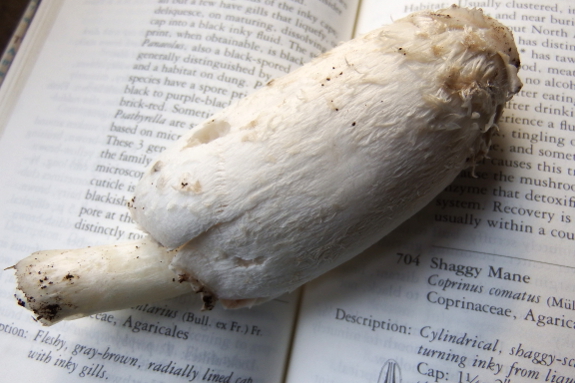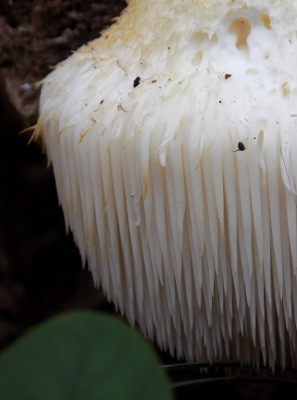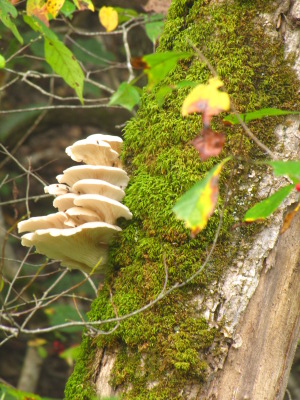
Wildcrafting mushrooms (and not killing yourself)

A few readers have asked
how we manage to eat wild mushrooms without killing ourselves. Since we
added a new species --- shaggy mane --- to our repertoire this week, I
thought now would be a good time for some fungal wildcrafting tips.
 First
of all, when I'm out in the woods, I only select the really easy
edibles, species that are awfully hard to confuse with anything
poisonous. After reading a few mushroom books and websites and hanging
around with mushroom hunters, you'll hear the same names pop up over and
over. Morels, oysters, chicken of the woods, hen of the woods, chanterelle, lion's mane,
shaggy mane. These species are all pretty unique and have few or no
poisonous lookalikes. You'll notice, though, that I steer clear of even
prime edibles that are just plain old gilled fungi since they're too
easy to confuse with deadly species like amanitas.
First
of all, when I'm out in the woods, I only select the really easy
edibles, species that are awfully hard to confuse with anything
poisonous. After reading a few mushroom books and websites and hanging
around with mushroom hunters, you'll hear the same names pop up over and
over. Morels, oysters, chicken of the woods, hen of the woods, chanterelle, lion's mane,
shaggy mane. These species are all pretty unique and have few or no
poisonous lookalikes. You'll notice, though, that I steer clear of even
prime edibles that are just plain old gilled fungi since they're too
easy to confuse with deadly species like amanitas.
After finding one of
these easy mushrooms, I bring it home and look it up in at least two
sources. I have three mushroom field guides on my shelf and the internet
offers many additional photos and descriptions. There, I learn
warnings, such as the shaggy mane's ability to make you sick if you're
consuming alcohol that day or chicken of the wood's requirement for
thorough cooking. At the same time, I check distinctive field marks. In
this case, Mom and I had seen an older shaggy mane in the same spot
Friday that was mature enough to be disintegrating into the typical
black goo. Finding a younger mushroom that looked the same a few feet
away and a few days later made this a pretty safe ID.
 Next,
I restrain our enthusiasm and cook up only about a tablespoon of the
mushroom for our first meal. With a few exceptions, most poisonous fungi
aren't so strong that they'd kill us at that level of consumption. So I
figure the worst we'd have to put up with would be a round of stomach
upsets. That said, I often experience psychosomatic symptoms after
eating the test fungi, but Mark is less suggestible and doesn't get
them. I know the symptoms are psychosomatic because they promptly go
away when I get busy doing something else....
Next,
I restrain our enthusiasm and cook up only about a tablespoon of the
mushroom for our first meal. With a few exceptions, most poisonous fungi
aren't so strong that they'd kill us at that level of consumption. So I
figure the worst we'd have to put up with would be a round of stomach
upsets. That said, I often experience psychosomatic symptoms after
eating the test fungi, but Mark is less suggestible and doesn't get
them. I know the symptoms are psychosomatic because they promptly go
away when I get busy doing something else....
Then, for the next meal,
we gorge! Delicious, found fungi from our own woods --- what could
be better? (And, in case you're curious, the shaggy mane was about
equivalent to an oyster mushroom in flavor --- good but not
outstanding.)
In the end, I feel like
harvesting your own edible fungi using this method is actually safer
than eating store-bought food. I've wildcrafted quite a few mushrooms
and have never gotten sick, while I've had food poisoning from off-farm
food multiple times. So which is really more dangerous --- eating a
shaggy mane or buying that hamburger from McDonald's?
Want more in-depth information? Browse through our books.
Or explore more posts by date or by subject.
About us: Anna Hess and Mark Hamilton spent over a decade living self-sufficiently in the mountains of Virginia before moving north to start over from scratch in the foothills of Ohio. They've experimented with permaculture, no-till gardening, trailersteading, home-based microbusinesses and much more, writing about their adventures in both blogs and books.
Want to be notified when new comments are posted on this page? Click on the RSS button after you add a comment to subscribe to the comment feed, or simply check the box beside "email replies to me" while writing your comment.

I have to step in here and defend Chipotle. Notice they didn't close any OTHER Chipotle's in the country? Their food chain may not be perfect, but it's much more local than any other fast food place. I guarantee McDonalds would've recalled (they'd never close) from all over the country, instead of just two states. So that tells you that that burrito from Chipotle's I'll be (happily) eating this weekend in North Carolina does NOT get ingredients from California or Oregon. Much better than the average bear. Obviously, they still serve vegetables in the winter, so they can't get EVERYTHING locally sourced, but in 2013 will used more than 15 million pounds of local produce.
As much as I would love it, we can't all live like Anna and Mark, (my husband is just not a farmer, lol), but companies like Chipotle that are doing their best to be more sustainable.
Nita and Emily --- Now, now. No fighting over Chipotle.
Casey --- I almost put my mushroom field guides in the post, but figured (as usual) that it was too long already. I can't promise these are the very best out there, but these are the books on my shelf:
National Audobon Society Field Guide to North American Mushrooms --- Usually, I feel like Peterson's field guides are more complete, but no mushroom field guides are complete. This one is pretty acceptable and is my first go-to guide. (I know --- damning with faint praise.)
Mushrooms Demystified --- I like the fact that this book is written by an edible mushroom forager. It's a little less handy to me because it has more of a western focus, but many of the species are the same on the eastern half of the continent. It's also pretty technical --- a bit beyond my ken, really. But I like books I can grow into.
A Field Guide to Southern Mushrooms --- This was a hand-me-down a few years ago, so I'm still feeling it out. So far, I just use it as a backup to show me an extra picture or two of a mushroom I've ID'ed somewhere else.
As you can tell, I'm a field guide connoisseur. That said, I haven't researched mushroom field guides in over a decade, so I like to think something better might have come out in the interim. If so, I hope you'll post and let me know!
Okay, I couldn't resist --- I went and researched mushroom field guides. I think that if I were buying books today, I'd try out 100 Edible Mushrooms, since my specific focus at the moment is culinary. That said, if I were choosing just from a sense of wonder about the outdoors (which was my original focus), I'd probably nab Mushrooms of West Virginia and the Central Appalachians because it's nearly specific to where I live, is by a University Press, and is huge. That would be a real mushroom book to grow into.
All of that said, the reviews on Amazon seem to suggest that Mushrooms Demystified and the Audubon Guide are still the top choices for most fungiphiles.